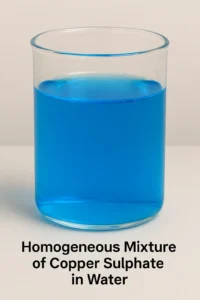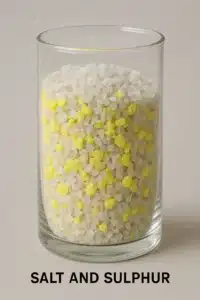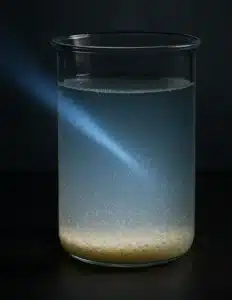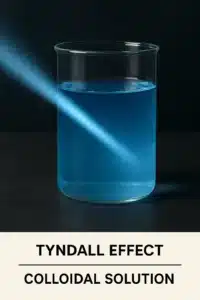Class 9 Science Chapter 2: Is Matter Around Us Pure? – Summary, Notes & Key Concepts (NCERT)
Are you a Class 9 student looking for an easy and complete revision of Chapter 2 – Is Matter Around Us Pure? This article provides a simple and clear summary, key definitions, and important differences covered in this chapter, as per the latest NCERT books. Whether you’re preparing for exams or quick revision, these notes will help you understand mixtures, solutions, elements, and compounds with examples and tables. These notes are also helpful for solving theoretical questions and MCQs from the textbook and school tests. See More For a better understanding of this chapter, you should also see MCQ on Is Matter Around Us Pure? Class 9 NCERT Solutions for Class 9 Science Chapter 2 – Is Matter Around Us Pure? |
1. Introduction to Matter in Our Surroundings
What is “Pure”?
For a common person, “pure” means having no adulteration. For example, milk is not “Pure.” It is actually a mixture of water, fat, proteins, etc.
However, for a scientist, a pure substance means all its constituent particles are the same in their chemical nature, consisting of a single type of particle.
What is a Mixture?
A mixture contains more than one substance (element and/or compound) mixed in any proportion.
The components of a mixture do not react chemically with each other.
Mixtures can be separated into pure substances using physical methods.
Types of Mixtures
Mixtures can be of two main types:
1. Homogeneous Mixture
A homogeneous mixture is a mixture which has a uniform composition throughout, and we cannot see the individual substances. A homogeneous mixture is also known as a solution.
Key Features:
It has a uniform appearance
Its components are not visible separately
Its properties are the same in every part of the mixture
Its components cannot be separated by simple physical methods
Examples:
- Salt dissolved in water
- Sugar dissolved in water
- Copper sulphate in water
Air
Vinegar

2. Heterogeneous Mixture
A heterogeneous mixture is a mixture which contains physically distinct parts and has non-uniform compositions.
Key Features:
It has a non-uniform composition.
Different parts have different properties.
- The different substances can be seen easily with the naked eye.
Its components can be easily separated by physical methods.
Examples:
Sodium chloride and iron filings
Salt and sulphur
Oil and water
Sand and water
Soil

What is a Solution?
A solution is a homogeneous mixture of two or more substances in which the solute is uniformly distributed in the solvent.
Examples from daily life: Lemonade, Soda water, etc.
Even though we usually think of solutions as liquids, they can also be:
Solid solutions (e.g., alloys like brass – a mixture of copper and zinc)
Gaseous solutions (e.g., air)
Components of a Solution
A solution is made up of:
Solvent is the substance that dissolves the other, usually in larger amount.
Solute is the substance that is dissolved, usually in lesser quantity.
Examples:
Sugar in water: sugar = solute, water = solvent
Iodine in alcohol (tincture of iodine): iodine = solute, alcohol = solvent
Soda water: carbon dioxide = solute, water = solvent
Air: oxygen and other gases = solute, nitrogen = solvent
Properties of a Solution
A solution is a homogeneous mixture.
Particles are smaller than 1 nm and cannot be seen with the naked eye.
It does not scatter light, so the path of light is not visible.
A solution is stable since the solute particles do not settle when left undisturbed.
The solute particles cannot be separated by filtration.
Concentration of a Solution
What is Concentration?
The concentration of a solution refers to the amount of solute present in a given amount of the solution (either by mass or volume).
Solutions can be dilute, concentrated, saturated, or unsaturated depending on the amount of solute and the temperature.
A solution with fewer solutes is called a dilute solution.
- A solution with more solute is called a concentrated solution.
- A saturated solution is one where no more solute can be dissolved at a given temperature.
- The amount of solute that can be dissolved in a solvent at a specific temperature is called its solubility.
- If the amount of solute contained in a solution is less than the saturation level, it is called an unsaturated solution.
Ways to Express Concentration
There are three common ways of expressing the concentration of a solution:
- Mass by mass percentage of a solution: (Mass of solute / Mass of solution) × 100
- Mass by volume percentage of a solution: (Mass of solute / Volume of solution) × 100
- Volume by volume percentage of a solution: (Volume of solute / Volume of solution) × 100
What is a Suspension?
A suspension is a heterogeneous mixture in which solute particles do not dissolve but remain suspended throughout the medium. These particles are large enough to be visible to the naked eye.
Examples of suspensions include chalk powder in water or wheat flour in water.
Properties of a Suspension:
A suspension is a heterogeneous mixture.
The particles are large enough to be seen with the naked eye.
The particles of a suspension scatter a beam of light passing through it and make its path visible.
The solute particles settle down when the mixture is left undisturbed, which means the suspension is unstable.
The solute particles can be separated from the mixture using the process of filtration.
When the particles settle down or are filtered out, the suspension breaks and it does not scatter light any more.

What is a Colloidal Solution?
A colloid or colloidal solution is a type of heterogeneous mixture, but it appears homogeneous because the particles are very small and evenly spread.
What is the Tyndall Effect?
The Tyndall effect is the scattering of a beam of light by colloidal particles. The path of the light becomes visible due to the tiny particles present in the colloid.
Examples where the Tyndall effect is observed:
Milk mixed with water
Sunlight passing through a small hole in a room
Sunlight streaming through a forest (because of water droplets in the mist)
Properties of a Colloid
A colloid is a heterogeneous mixture.
The size of particles of a colloid is too small to be seen individually with the naked eye.
Particles are uniformly spread throughout the mixture.
It shows the Tyndall effect because it scatters light.
The colloid is quite stable because particles do not settle down even if left undisturbed.
Particles cannot be separated by filtration, but can be separated by centrifugation.
Components of a Colloid
A colloidal solution has two parts:
Dispersed phase – The particles are called the dispersed phase.
Dispersion medium – The medium in which they are distributed is called the dispersion medium.

Separating the Components of a Mixture
How Can We Obtain Coloured Component(Dye) from Blue/Black Ink?
We can obtain the coloured part of the ink by using evaporation methods. As we know, ink is a mixture of dye (colour) and water. By the process of evaporation, the liquid part (water) evaporates, and the coloured dye is left behind.
How Can We Separate Cream from Milk?
We can use a centrifugation method to separate cream from milk.
What is Centrifugation?
Centrifugation is a method used to separate particles from a liquid by spinning the mixture at a high speed. When a mixture is rotated very fast the heavier particles settle down, while the lighter ones stay on top.
It is commonly used in dairies, laboratories, and washing machines
How Can We Separate a Mixture of Two Immiscible Liquids?
When two liquids do not mix with each other (like oil and water), they are called immiscible liquids. We can separate them using a separating funnel.
How Can We Separate a Mixture of Salt and Ammonium Chloride?
Salt and ammonium chloride form a solid-solid mixture. The sublimation process is used to separate a mixture of Salt and Ammonium Chloride.
What is Sublimation?
Sublimation is the process in which a solid changes directly into a gas without changing into a liquid state.
Examples of Sublimable Substances:
- Ammonium chloride
- Camphor
- Naphthalene
- Iodine
- Dry Ice (Solid CO2 )
Is the Dye in Black Ink a Single Colour?
Black ink is not a single colour but a mixture of different coloured dyes. Chromatography helps to separate and identify these colours.
What is Chromatography?
Chromatography is a method used to separate and identify different colours or substances present in a mixture.
Example:
If we put a drop of black ink on filter paper and dip it in water, the colours in the ink will separate and spread on the paper—showing that black ink is made of many different dyes.
It is used to:
- Separate dyes in ink
- Separate pigments from natural colours
- Separate drugs from blood.
- Check purity of substances
- Identify different components in mixtures
How Can We Separate a Mixture of Two Miscible Liquids?
When two liquids mix completely with each other (like alcohol and water), they are called miscible liquids. We can separate them using simple distillation.
What is Distillation?
Distillation is a process used to separate a liquid from a mixture by heating it until it turns into a vapour and then cooling it to get the liquid back.
Or
Distillation is a process used to separate a liquid from a mixture by utilizing the differences in their boiling points by heating it. The liquid with the lower boiling point boils first, turns into vapour, then cooling and condensing those vapours back into a liquid, while leaving the higher boiling point components behind.
Uses of Distillation:
- To purify drinking water
- To separate alcohol from water
- In making perfumes and medicines
How Can We Obtain Different Gases from Air?
Air is a homogeneous mixture of many gases like nitrogen, oxygen, carbon dioxide, etc. These gases can be separated using a method called fractional distillation.
What is fractional distillation?
Fractional distillation is a process used to separate a mixture of two or more liquids that have different boiling points. In this process mixture is heated so that each liquid boils at its own temperature, turns into vapour, and is then cooled and collected separately.
Steps to Separate Gases from Air:
- The air is compressed by increasing the pressure and then cooled by decreasing the temperature to get liquid air.
- This liquid air is slowly warmed in a fractional distillation column.
- Different gases boil at different temperatures and turn back into gases one by one.
- Each gas is collected separately.
Arrange the gases present in air in increasing order of their boiling points.
The primary gases in air are nitrogen (N₂), oxygen (O₂), argon (Ar), carbon dioxide (CO₂), and trace amounts of others like neon (Ne), helium (He), and krypton (Kr). To arrange them by increasing boiling points, we consider their boiling points at standard atmospheric pressure:
- Nitrogen – –196°C
- Argon – –186°C
- Oxygen – –183°C
Increasing order of boiling points: He < Ne < N₂ < Ar < O₂ < Kr < CO₂
Which gas forms the liquid first as the air is cooled?
As air is cooled, the gas with the highest boiling point condenses (turns into liquid) first.
So, Oxygen (–183°C) forms the liquid first when air is cooled.
How Can We Obtain Pure Copper Sulphate from an Impure Sample?
To get pure copper sulphate crystals from an impure sample, we use a method called crystallisation.
What is Crystallisation?
Crystallisation is a process used to purify solid substances. It gives us pure and large crystals of a substance by removing impurities.
Why is the use of crystallisation better than simple evaporation?
Crystallisation is a better method than simple evaporation because:
- ️ It gives pure crystals of the substance.
- ️ Some solids may decompose or get charred on strong heating during evaporation.
- ️ Impurities may not be removed completely by evaporation.
- ️ Crystallisation helps in removing these impurities and gives clean, shiny crystals.
Application of Crystallisation
- Purification of salts that we get from sea water.
- Separation of crystals of alum ( phitkari) from impure samples.
Steps in the Drinking Water Purification System:
- Sedimentation:
- Water is allowed to stand still so that heavy impurities (like sand and mud) settle down at the bottom.
- Loading:
- Alum (fitkari) is added to help fine particles settle down faster.
- Filtration:
- The water is passed through layers of sand and gravel to remove remaining solid impurities.
- Chlorination:
- A small amount of chlorine is added to kill germs and bacteria.
- Clean and safe drinking water is supplied to homes.
Physical and Chemical Changes
Physical Change
A physical change is a change in which no new substance is formed. It only affects the physical properties such as shape, size, state, or appearance of a substance, while its chemical composition remains the same. Physical changes are usually reversible.
Examples:
Melting of butter in a pan
The interconversion of states (solid ↔ liquid ↔ gas) is a physical change.
Chemical Change
A chemical change is a change in which one or more new substances are formed. It involves a change in the chemical composition and chemical properties of the original substance. This type of change is usually irreversible by simple physical methods.
Examples:
Rusting of iron
Burning of paper or wood
Cooking of food
What are the Types of Pure Substances?
On the basis of their chemical composition, substances can be classified either as elements or compounds.
Elements
An element is a basic form of matter that cannot be broken down into simpler substances by chemical reactions.
- Robert Boyle was the first scientist to use the term element in 1661.
- Antoine Laurent Lavoisier was the first to establish an experimentally useful definition of an element in the 18th century.
Classification of Elements
Elements can be normally divided into metals, non-metals and metalloids.
1. Metals
Metals usually show some or all of these properties:
They have a lustre (shine).
They have silvery-grey or golden-yellow colour.
They are good conductors of heat and electricity.
They are ductile, meaning they can be drawn into thin wires (like copper wire).
They are malleable, meaning they can be hammered into thin sheets (like aluminium foil).
They are sonorous, meaning they produce a ringing sound when struck.
Examples:
Gold, silver, copper, iron, sodium, potassium, etc.
Mercury is the only metal that is liquid at room temperature
2. Non-metals
Non-metals usually show opposite properties to metals:
They show a variety of colours.
They are poor conductors of heat and electricity.
They are not lustrous, sonorous, or malleable.
Examples:
Hydrogen, oxygen, iodine, carbon (coal, coke), bromine, chlorine
3. Metalloids
Metalloids are elements that have intermediate properties between metals and non-metals.
Examples:
Boron, silicon, germanium
Other Facts About Elements:
There are more than 100 elements known today.
92 elements occur naturally, and the rest are man-made.
Most elements are solids.
11 elements are gases at room temperature.
2 elements – mercury and bromine – are liquids at room temperature.
Gallium and cesium become liquid just above room temperature (303 K).
Compounds
A compound is a pure substance composed of two or more elements, chemically combined in a fixed proportion.
When elements combine to form a compound, they lose their individual properties, and the new compound has entirely different properties from its elements.
Characteristics of a Compound
A compound is formed when two or more elements react chemically.
It has a fixed composition.
It has a uniform texture and colour throughout.
The properties of a compound are different from the properties of the elements it is made from.
The components of a compound cannot be separated by physical methods—only by chemical or electrochemical reactions.
Difference Between Mixture and Compound
| Mixture | Compound |
|---|---|
| A mixture is formed by physically combining two or more substances. | A compound is formed by a chemical reaction between elements. |
| It does not form a new substance. | It forms a new substance with different properties. |
| It shows the properties of all its components. | It has different properties from the elements it is made from. |
| It can have any proportion of its components (not fixed). | It has a fixed ratio of elements. |
| The components of a mixture can be separated by physical methods. | The components of a compound can be separated only by chemical methods. |
| Salt water, air, sand and iron filings are mixtures. | Water (H₂O), carbon dioxide (CO₂), iron sulphide (FeS) are compounds. |
Difference Between Elements and Compounds
| Element | Compound |
|---|---|
| An element is a pure substance that cannot be broken down into simpler substances by chemical reactions. | A compound is a pure substance formed when two or more elements combine chemically in a fixed ratio. |
| It is made of only one kind of atom. | It is made of two or more types of atoms chemically combined. |
| The properties of an element are unique to that element. | A compound has different properties from the elements it is made from. |
| It cannot be broken down by any chemical method. | It can be broken down into simpler substances by chemical methods. |
| Elements are classified as metals, non-metals, and metalloids. | Compounds are classified as organic and inorganic compounds. |
| Iron (Fe), Hydrogen (H₂), Oxygen (O₂) are elements. | Water (H₂O), Carbon dioxide (CO₂), Sodium chloride (NaCl) are compounds. |
Difference Between Homogeneous and Heterogeneous Mixtures
| Homogeneous Mixture | Heterogeneous Mixture |
|---|---|
| A homogeneous mixture has a uniform composition throughout. | A heterogeneous mixture has a non-uniform composition. |
| The entire mixture looks the same in all parts. | The mixture looks different in different parts. |
| The particles are not visible to the naked eye. | The particles are often visible to the naked eye. |
| It consists of only one phase. | It consists of two or more phases. |
| Components cannot be separated easily by physical methods. | Components can be separated easily by physical methods. |
| Example:- Salt in water, sugar in water, etc. | Example:- Oil and water, sand and iron, etc. |
Difference Between Suspension and Colloidal Solution
| Suspension | Colloidal Solution |
|---|---|
| It is a heterogeneous mixture. | It is also a heterogeneous mixture, but it appears homogeneous to the naked eye. |
| Its particles are visible to the naked eye. | Its particles are not visible to the naked eye. |
| It is unstable because particles settle down even if left undisturbed | It is quite stable because particles do not settle down even if left undisturbed. |
| It may show the Tyndall effect (if particles are large) | It always shows the Tyndall effect |
| It can be separated by filtration | It cannot be separated by filtration |
| Example:-Sand in water | Example:- Milk, soap solution |
Difference Between a Solution and a Suspension
| Solution | Suspension |
|---|---|
| It looks the same throughout. | It does not look the same throughout. |
| We cannot see the solute particles. | We can see the particles with our eyes. |
| The solute dissolves completely in the solvent. | The particles do not dissolve. |
| It is quite stable because if we leave it undisturbed, nothing settles down. | It is unstable because particles settle down after some time. |
| It does not scatter light. | It may scatter light. |
| We cannot separate the solute by filtration. | We can separate the particles by filtration. |
| Example: Salt in water, sugar in water | Example: Sand in water, muddy water |
NCERT Notes for Class 9 Science
- Chapter 1 Matter in Our Surroundings Class 9 Notes
- Chapter 2 Is Matter Around Us Pure Class 9 Notes
- Chapter 3 Atoms and Molecules Class 9 Notes
- Chapter 4 Structure of the Atom Class 9 Notes
- Chapter 5 The Fundamental Unit of Life Class 9 Notes
- Chapter 6 Tissues Class 9 Notes
- Chapter 7 Diversity in Living Organisms Class 9 Notes
- Chapter 8 Motion Class 9 Notes
- Chapter 9 Force and Laws of Motion Class 9 Notes
- Chapter 10 Gravitation Class 9 Notes
- Chapter 11 Work, Power And Energy Class 9 Notes
- Chapter 12 Sound Class 9 Notes
- Chapter 13 Why Do we Fall ill Class 9 Notes
- Chapter 14 Natural Resources Class 9 Notes
- Chapter 15 Improvement in Food Resources Class 9 Notes
